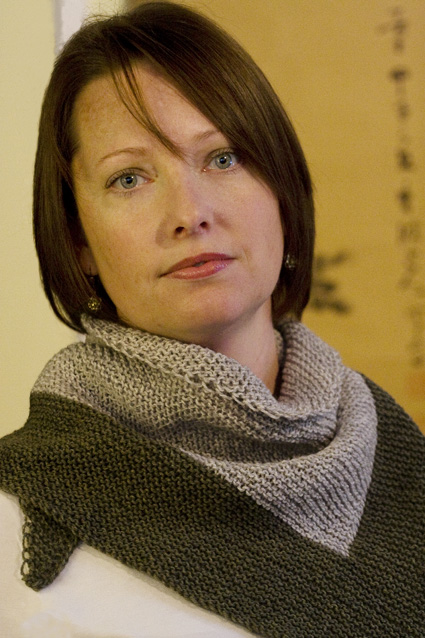

|
|
|
|
 |
 |
translated by Franklin Habit from Mrs
Gaugain’s Miniature Knitting, Netting and Crochet
Book (c. 1843)
|
 |
| SIZE |
| One |
|
FINISHED MEASUREMENTS |
Width: 40 inches |
|
MATERIALS Notions |
| GAUGE |
20 sts/40 rows = 4" in garter stitch |
|
PATTERN NOTES |
This project is worked flat, in one piece, in garter stitch. Instructions for the Shawl Variation follow the Neckerchief pattern. Slipped sts: Slip all slipped sts purlwise, with yarn held to front of work. Bring yarn between needles to back of work before working next st. Yarnover at beginning of row: Bring the working yarn from front to back over the right needle before knitting the next stitch. This is the method of increase employed at the long (top) edge of the triangle, and it creates a very pretty row of loops at the edge. Joining a new color: Mrs. Gaugain calls for the knitter to “tie on” a new color when it is introduced at the beginning of a RS row. I prefer, instead, to thread the strand of the new color onto a yarn needle and weave it lightly into the WS of the fabric near the edge of the work, so that the first maneuver of the RS row (a yarnover – see above) can be performed. This initial weaving can be neatened up during the finishing process. Changing colors within a row: When switching from one color to the next on a RS row, drop the color you have been knitting with, and bring the yarn for the next color up under the yarn of the previous color before you continue knitting. This will twist the strands around each other, preventing a gap from forming where the colors meet. On WS rows, bring the old color between the needles to the front of the work, bring the yarn for the next color up under the yarn of the previous color and between the needles to the back of the work. (Yes, it’s intarsia. But I won’t tell anybody if you won’t.) Historic colors: The original pattern suggests pink or blue for the border, and white for the center. |
|
DIRECTIONS |
|
Begin Right Border: Using CC, CO 3 sts. After you have worked the first few rows, use safety pin or split ring marker to mark RS of work. Row 1 [WS]: Sl 1, k2. Begin Center and Continue Right Border: Work Left Border: |
| Finishing |
| Gently wet block, taking care to keep edges straight and short sides equal in length. When dry, weave in ends on WS. |
| Shawl variation |
This pattern is the smaller cousin of Mrs. Gaugain’s “Chinee [sic] Wrapping Shawl” from the same volume. To work the shawl, use a yarn of the same weight, but needles two sizes larger (gauge will be very loose). Work pattern as written, but continue working second section (center and right border) until the piece measures 1.25yd along shaped edge. Finish by working the left border as written. For the shawl, Mrs. Gaugain suggests a brown border with a pink or blue center. |
|
|
| ABOUT THE DESIGNER |
| Franklin Habit is the author of an extremely
silly knitting book, It
Itches: A Stash of Knitting Cartoons Franklin spends so much time on the road these days, teaching and speaking about knitting, that American Airlines has just sent him a highly suggestive mix tape. |
| Pattern & images © 2011. Franklin Habit. |